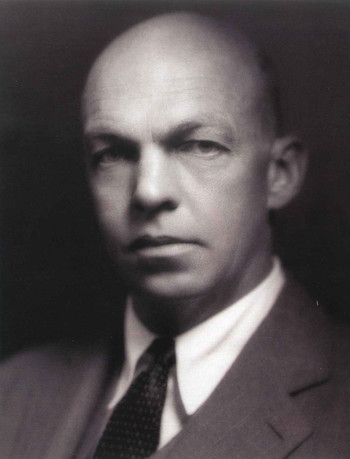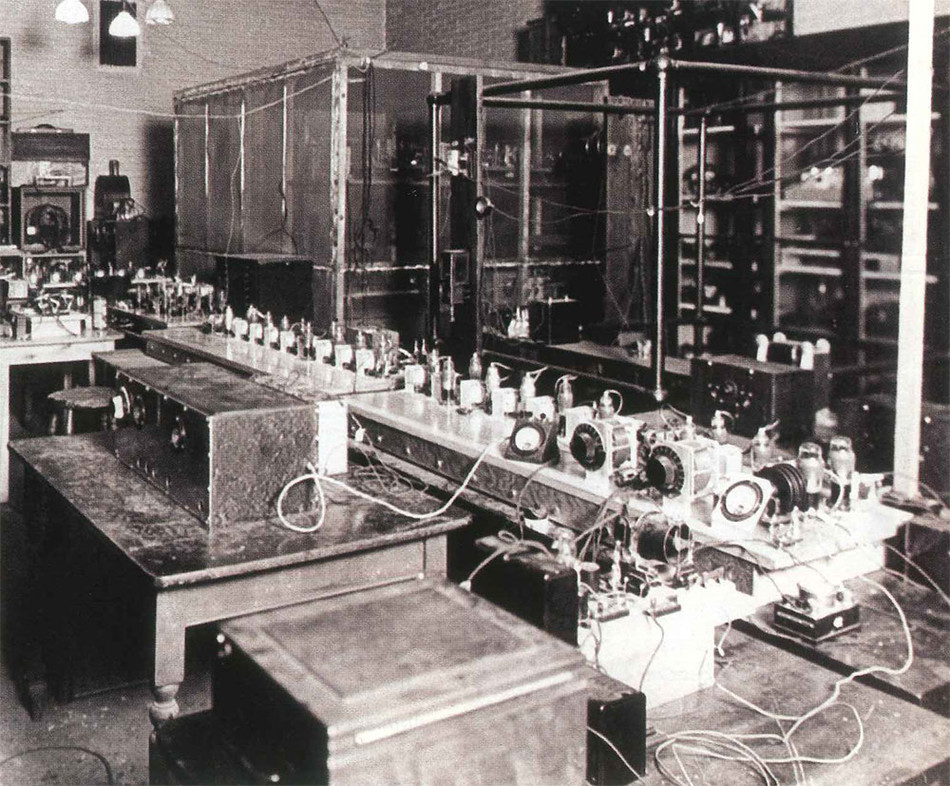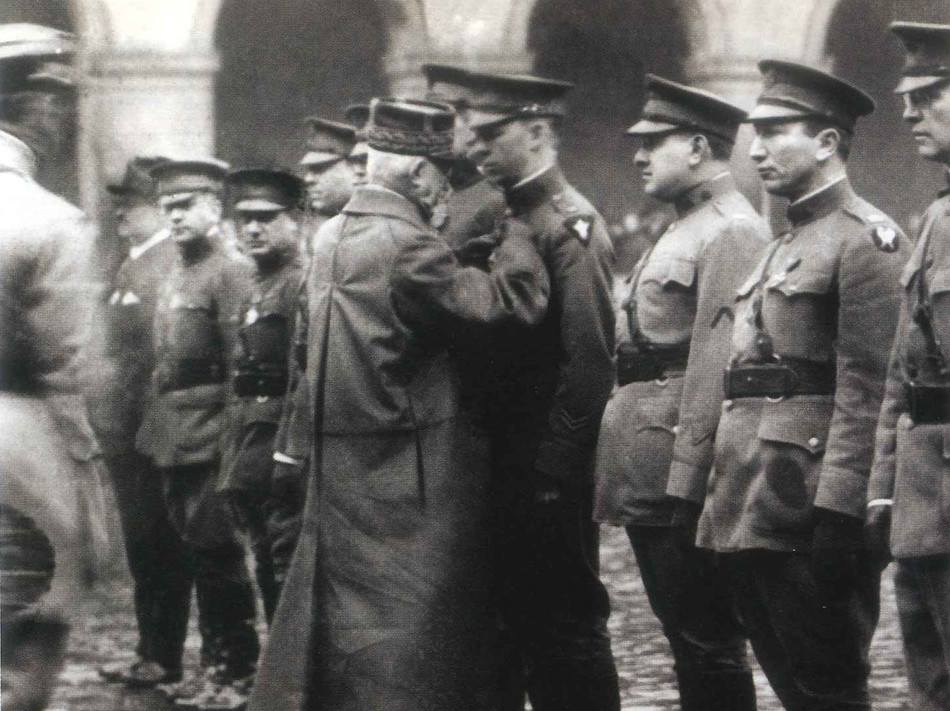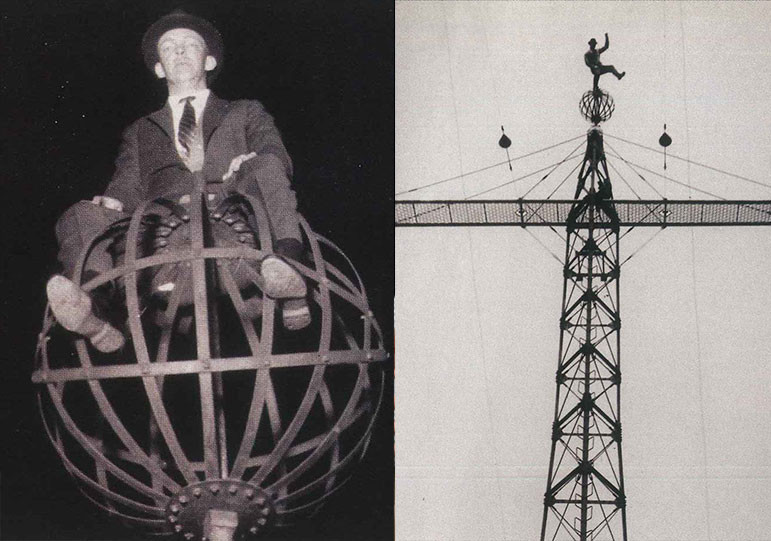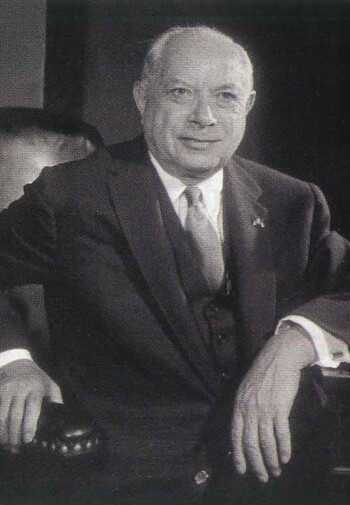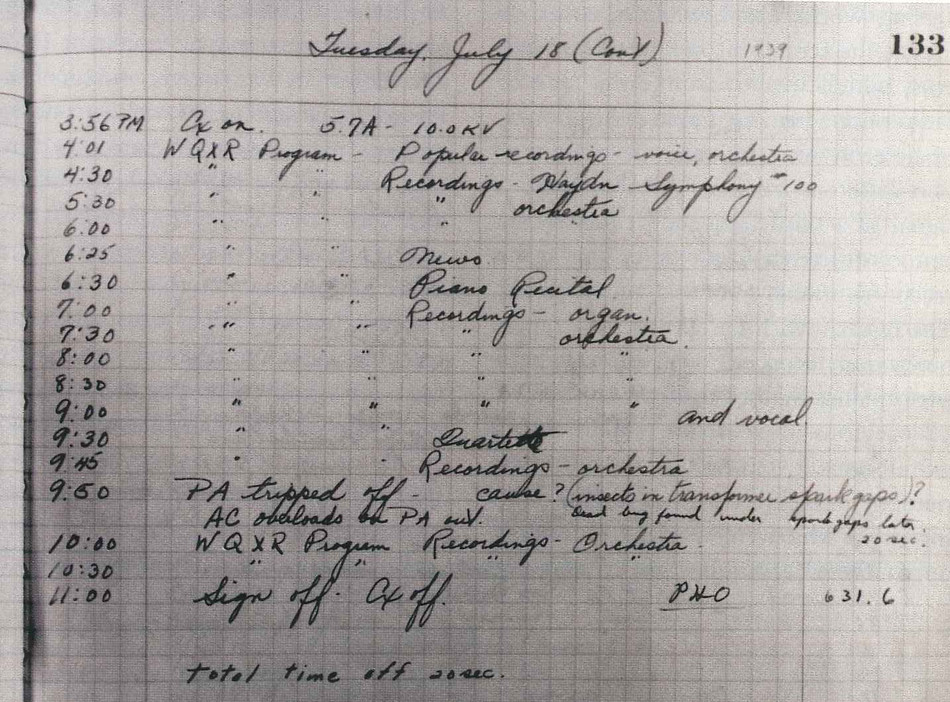The chief object of science is to explain nature. The chief object of engineering and technology is, or should be, to put nature to work for us. Much of the technology that has transformed modern life is based on the work of unusually creative people, many of whom remain relatively unknown. One striking example is Edwin Howard Armstrong ’13E ’29HON, who spent his adult life at Columbia, first as a student and then as a faculty member. His should be a household name next to Edison’s, and the reasons why this is not so—and Armstrong’s life in general—tell a sad but fascinating story.
In contrast to many inventors (Edison included), Armstrong had a distinctly analytical mind. Instead of working by trial and error, he would proceed methodically toward identifying the root cause of a problem in order to find a path toward a solution. He placed his physical intuition above everything else, and in fact mistrusted results based only on mathematics; he knew well that those are only as good as the assumptions behind them, which do not always correctly model the physical world. He delighted in plunging into areas that others had pronounced hopeless, and he did so with single-minded determination. He was one of those rare individuals who, with a master stroke, came up with ideas that resulted in quantum leaps in technology—and not just once, but three times. His work has made FM radio possible, and is responsible for the circuit architecture in practically every modern radio, television set, and many cellular phones.
Why, then, have so many people never heard of Armstrong? The answer is ironic: Armstrong was all substance and no style. He could not play public relations games and was naive enough to underestimate the power of those whose interests were threatened by his inventions. At the same time, he refused to compromise. In the end, he fell victim to the very stubbornness that made possible his spectacular technical successes.
The dawn of the wireless age
Edwin Howard Armstrong was born in Chelsea, New York City, in 1890. Shy as a child, perhaps because of a tic left by a bout of rheumatic fever, he often played alone. At fourteen, after his family moved to Yonkers, he became fascinated by the stories of great scientists and inventors, in particular those of Michael Faraday and Guglielmo Marconi. He resolved that he, too, would be an inventor. Like many boys his age at the beginning of the century, he became fascinated with the new art of wireless and began building crystal sets—the simple receivers that marked the beginning of the wireless age. Back then Morse code was the only thing one could listen to, and to make out the faint signals one had to wear headphones in a quiet room. He resolved to find a way to increase the volume of those signals and to pick them up from the greatest possible distance.
Armstrong finished high school and was admitted to Columbia’s Department of Electrical Engineering in 1909. He plunged into the study of electricity with a determination that was to characterize him for the rest of his life. He never took things for granted; he wanted to know why things were as his p rofessors were telling him, and he often questioned their assertions with a self-confidence sometimes mistaken for arrogance. He valued and credited great minds—but he had no patience for those without substance who posed as great scientists and inventors. His passion to search and expose the truth angered many people.
As a junior at Columbia, Armstrong came to know well Professor Michael I. Pupin ’1883C, a founding member of the Department of Electrical Engineering. Pupin was an important inventor himself, having contributed, among other things, to making long distance telephony possible. Pupin became Armstrong’s mentor and supporter, and made available to him his lab in the basement of Philosophy Hall. This was to become the main testing ground of Armstrong’s creative ideas for the rest of his life. Pupin, with some of his colleagues, was also instrumental in defending Armstrong in front of an irate faculty who objected to the ways of the young student.
Regeneration
At about the time these events were taking place, another inventor, Lee De Forest, was making waves. A graduate of Yale University, he had expanded on Fleming’s electron tube by adding a third electrode and forming what he called the “audion”—the triode tube, as it later came to be called. De Forest had tried to apply his tube in radio reception, but had achieved only a small improvement—radio signals still came in as faintly as before, requiring one to press the headphones tightly across one’s ears in order to barely hear them. Armstrong studied the audion for several years, performed extensive measurements, understood and explained its operation (a feat that had eluded the audion’s inventor himself), and set out to find a way to use it to truly amplify radio signals. The idea hit him while on summer vacation in 1912, just before his senior year at Columbia: he would pass the signals through an audion circuit and feed them back to the input of the circuit in such a way as to make them reinforce themselves. He expected that this “positive feedback” would result in regeneration and great amplification—in fact, by a factor of thousands.
As soon as he returned from vacation, Armstrong tried his idea in his attic. His sister recounts how Armstrong burst into her room late in the night, dancing around and screaming, “I’ve done it!” Loud signals, clearly heard across the room, were emanating from the headphones left on his bench. What is more, Armstrong discovered that, when the positive feedback was sufficiently increased, the circuit became an “oscillator,” and was able to transmit its own signal. Thus, in one masterstroke, a sensitive “regenerative” receiver and an effective electronic transmitter had been born.
The beaming student tried to patent his invention. His father, worried that this sort of extracurricular activity would interfere with his son’s progress toward graduation, refused to give him the money. Armstrong had to borrow from relatives and friends and even had to sell his beloved red motorcycle—a high school graduation gift that he had been using to commute between Yonkers and Columbia. He applied for a patent in 1913, and this patent was issued the following year. Soon radios based on Armstrong’s invention began to appear. Radio communication had finally become practical.
Armstrong graduated with a degree in electrical engineering in 1913 and was offered a position of assistant the same year. He hung a huge antenna between Philosophy, Havemeyer, and Schermerhorn halls and was able to demonstrate to an amazed Pupin reception of signals from as far away as Honolulu. More demonstrations followed, including one to a visiting group of engineers from American Marconi. This group included David Sarnoff ’66HON, who was to become Armstrong’s friend and, later, his nemesis.
One of Armstrong’s demonstrations was held in the course of a conference held by the the Institute of Radio Engineers (IRE) at Columbia. De Forest was in the audience. The two had never met, and the occasion marked the first time De Forest had heard his audion truly amplify. It also marked the beginning of his animosity toward Armstrong, one that would only intensify in the years ahead.
Soon after Armstrong’s success, De Forest began claiming that the idea of regeneration was his. He had observed a “howling” in his amplifiers; this, in hindsight, was the result of accidental positive feedback. Although he had never mentioned feedback at that time, never took advantage of it, and in fact tried to suppress its effects in his amplifiers, he now filed patent applications that resulted in interference proceedings with Armstrong’s patents. In the meantime, Armstrong was publishing technical papers explaining correctly for the first time how De Forest’s audion actually worked.
A battle ensued, too long and too complicated to present here. It began shortly after the end of World War I and continued for many years. Repeatedly during this battle it was shown beyond doubt that Armstrong was the true inventor of the regenerative circuit. Several faculty members of the Department of Electrical Engineering testified in court, and several graduates of Columbia’s Law School represented Armstrong. Repeatedly it became apparent that, when pressed in the course of court proceedings, De Forest did not understand how his own audion worked. An embarrassed De Forest escalated the legal battles, now backed by AT&T, which had purchased his patents, including the ones in interference with Armstrong’s. The courts decided in favor of Armstrong several times, with these outcomes followed by reversals. In 1934 the Supreme Court, unable to understand scientific facts, found in favor of De Forest on the basis of a language detail.
The absurdity of the courts’ decision was plainly evident to the technical community. The IRE had earlier given Armstrong its Medal of Honor for the discovery of the regenerative circuit. Now, a disheartened Armstrong attempted to return the medal during an IRE convention. They refused to accept it and gave him a standing ovation. In 1941, the Franklin Institute gave Armstrong the Franklin Medal for the regenerative circuit, and in 1942 the American Institute of Electrical Engineers awarded him the Edison Medal. He was similarly honored in Europe.
The superheterodyne receiver
Armstrong had not been technically idle during his long battle with De Forest. During World War I, while stationed in France, he scored his second major success, which would change the face of radio once again. He applied the concept of heterodyning (mixing the signals of two different frequencies to produce a signal of a third frequency, equal to the sum or difference of the first two), to the reception of high-frequency radio signals. The result, which he termed the “superheterodyne receiver,” was of such high performance that it eventually superseded all previous approaches, including his own regenerative receiver. Armstrong had outdone himself, as well as several other inventors who were working on related approaches at about the same time. Today, practically all modern radio and TV receivers, as well as many types of cellular phones and other communications devices, use the superheterodyne approach.
Armstrong rose to the rank of major, and the French government gave him access to the Eiffel Tower for his experiments and named him a Chevalier de la Légion d’Honneur. He filed for a patent for his superheterodyne circuit in 1918, and the patent was issued two years later. He sold this patent, as well as one for another invention—the superregenerative receiver—and by 1923 he was a millionaire. Now an assistant professor at Columbia, he decided to accept no salary from the University. In this way, he could avoid administrative work and even teaching and could devote his energies to research—and to his legal battles. At about the same time, he married Marion MacInnis, Sarnoff’s former secretary—a woman with plenty of understanding for her driven husband. She would be his companion for the next thirty years.
FM radio
It is amazing that while Armstrong was fighting his endless legal battles with De Forest, he had the energy to be working at the same time on another idea—FM radio. This was the result of a long study he had initiated with Pupin: to combat the problem of static in AM radio, the established technique at the time.
AM, or amplitude modulation, is the technique of varying the amplitude, or strength, of a radio signal in accordance to the voice or music being transmitted. A radio receiving this signal is sensitive to such amplitude variations but is also sensitive to other disturbances related to amplitude, notably static due to thunderstorms, electrical machinery, and so on. The technical wisdom of the time held that nothing could be done about this. “Static, like the poor, will always be with us,” a well-known engineer had pronounced. But Armstrong was unfazed. He believed that if, instead, one varied not the amplitude but the frequency of the signal being transmitted, the receiver could be designed so that it would respond to frequency changes rather than to amplitude changes—and would thus be oblivious to static. This is FM, or frequency modulation.
Others had considered FM before Armstrong, but the verdict was that it offered no advantages over AM. When a mathematical analysis by AT&T scientist John Carson was quoted as conclusive proof of this, the technical community committed the kind of logical error that, unfortunately, continues to be quite common. Someone proves a statement based on certain assumptions; others forget those assumptions and remember only the conclusions. People then tend to apply such conclusions to all cases, even ones that do not satisfy the original assumptions. This is what had happened here, and it was tantamount to a prejudice against FM.
The assumption under which FM has no advantages over AM is that its spectrum would occupy a narrow band of frequencies, a property considered at the time to be desirable for keeping noise low. Armstrong, in a brilliant moment of lateral thinking, decided to challenge that wisdom, and set out to find out what would happen if he used instead a wide band of frequencies for his FM signal. After years of painstaking experiments, with equipment spread over several tables in Philosophy Hall and involving as many as a hundred electron tubes, he was able to prove that wideband FM made possible a drastic reduction of noise and static (a hundredfold, or even more). Since everyone else had followed the common wisdom that “wideband is bad,” Armstrong was free to pursue FM by himself. By 1934, he had filed a series of patents relating to his latest brainchild.
Now a full professor, Armstrong was ready for a demonstration. During an IRE conference in 1935, he described FM radio and then turned on his receiver in front of the audience. An FM transmission from a friend’s house in Yonkers came in totally free of static and, thanks to the wide audio spectrum being used, with a fidelity never heard before. A stunned audience listened to a live music performance transmitted with remarkable clarity and to a series of sounds, such as a glass of water being poured or a piece of paper being torn—which would have been unrecognizable over AM radio.
The results of the demonstration were the opposite of what one would expect. As Sarnoff put it, he was expecting an evolution in the AM system that would reduce static; instead, Armstrong came up with a revolution. FM radio was so much better than AM that the whole established order of things was threatened. Thousands of AM transmitters and millions of AM radios could become obsolete. The established broadcasting networks, their investments, and their markets, were in jeopardy. In addition, FM could interfere with the industry’s up-and-coming big new sensation: television broadcasting, at the time being readied for the market by RCA under Sarnoff’s leadership. Thus, ten days after Armstrong’s demonstration of FM, the public was reading RCA’s extensive public releases concerning the upcoming marvel of television—with no word about FM.
Not even De Forest’s legal battles had prepared Armstrong for what was coming. This time he was up against too much and too many. To him, things were clear: since FM was proved beyond doubt to be immensely superior to AM, the public had the right to its benefits. He bet everything on this logic and decided to go it alone against corporate interests and lobbying efforts. Sarnoff asked him to remove his equipment from the top of the Empire State Building, to which he had given him access initially for his FM experiments. Various reports on the state of the art in communications ignored FM completely, including the Federal Communications Commission’s annual report to Congress. The view was propagated that the public is not interested in high fidelity and would not pay for it. But Armstrong was convinced that FM radio would succeed. The only thing that could temporarily slow it down was, in his words, “those intangible forces so frequently set in motion by men, and the origin of which lies in vested interests, habits, customs, and legislation.”
Yet Armstrong had not realized what he was up against. The FCC was successfully lobbied to turn down his request for an experimental FM station license. When he threatened to take his development of FM overseas, he got the license and a tiny FM band. The first FM station began broadcasting from Alpine, New Jersey, in 1939. The tiny “Yankee Network” in New England adopted FM and began spreading it. In 1940 RCA made Armstrong an offer to buy a license from him. He refused, insisting that they should pay royalties as other companies were doing, and under the same terms. But RCA had been doing its own FM radio development in the meantime, and they and other companies were soon selling FM radios, ignoring Armstrong’s patents. At the end of World War II, the FCC moved FM’s existing band to higher frequencies “for FM’s own good,” and drastically reduced the maximum power allowed to an FM transmitter. The result was instant obsolescence of all existing FM transmitters and receivers as well as greatly limited coverage.
But Armstrong would not give up. With the help of a few sympathetic senators, he carried the fight into Congress. In 1948 Armstrong charged RCA and NBC with infringement. An army of lawyers began pre-court proceedings, which were to last for several years. Armstrong was interrogated endlessly during these proceedings about irrelevant details, from his income tax and the size of the rooms in which he gave speeches to why he used Columbia letterhead for some of his communications and whether he had a formal agreement with the University. It took years to get these pre-court proceedings to the point that Sarnoff was called in as a witness.
Armstrong was now deteriorating quickly. He had predicted that “they will stall this along until I am dead or broke.” His fortune had been depleted on legal fees, and his health was worsening. Nearing breakdown, saddened beyond hope, he became obsessed and desperate. On Thanksgiving night, 1953, he quarreled with his wife, and she left to live with her relatives.
On the night of January 31, 1954, Armstrong put on his overcoat, scarf, gloves, and hat, opened his window, and jumped out, falling ten stories to his death.
A note was found on his desk, written to his wife, talking about his deep grief for having hurt her and how his battles had broken him. “God keep you and the Lord have mercy on my soul,” the note ended.
Epilogue
One month before his death, Armstrong had filed 21 infringement suits. His wife, Marion, carried on the battle, and by the mid-sixties had won two and settled all others successfully. Dana Raymond ’39L, a young lawyer who had been at her husband’s side ever since graduating from Columbia’s Law School, was instrumental in these efforts.
In 1955, the Union Nationale des Télécommunications in Geneva added Armstrong’s name to the list of such great men of electricity and telecommunications as André-Marie Ampère, Alexander Graham Bell, Michael Faraday, Carl Friedrich Gauss, Heinrich Hertz, William Thomson Kelvin, Guglielmo Marchese Marconi, James Clerk Maxwell, Samuel F.B. Morse, Michael Pupin, and Nikola Tesla. A U.S. postal stamp was issued in his honor in 1983. He was inducted posthumously to the Consumer Electronics Association Hall of Fame in 2000, “in recognition of his contributions and pioneering spirit that have laid the foundation for consumer electronics.”
Armstrong was the victim of a world in which, as he eloquently put it, “men substitute words for realities, and then talk about the words.” Next time you turn on your FM radio or your cellular phone, think of that—and of him.
